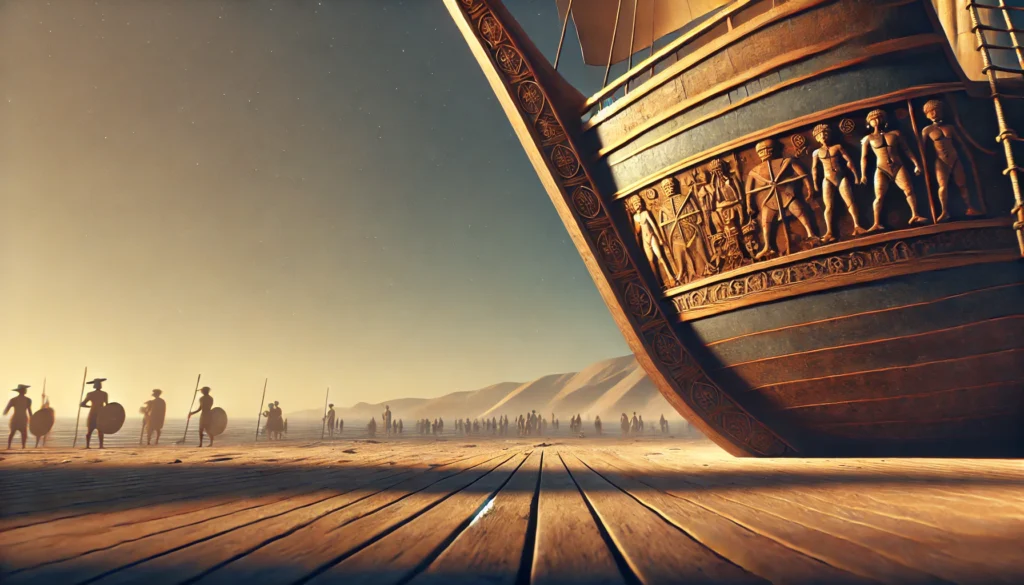The dawn of the 16th century marked a pivotal moment in human history, known as the Age of Exploration. European nations, driven by a combination of economic ambition, religious fervor, and scientific curiosity, embarked on daring voyages across uncharted seas. Portugal and Spain led this maritime revolution, each vying for dominance in the race to discover new trade routes and lands. It was against this backdrop of competition and discovery that Ferdinand Magellan, a Portuguese explorer in the service of the Spanish crown, set sail on a journey that would forever change the course of history.
Magellan’s Expedition
Ferdinand Magellan, born into a noble Portuguese family around 1480, had already established himself as a skilled navigator and explorer by the time he proposed his ambitious expedition to the Spanish King Charles I. His plan was audacious: to find a western route to the lucrative Spice Islands, challenging the Portuguese monopoly on eastern trade routes. On September 20, 1519, Magellan set sail from Sanlúcar de Barrameda with a fleet of five ships and approximately 270 men. Little did they know that their journey would lead to the first circumnavigation of the globe and the unexpected discovery of the Philippine archipelago.
The Arrival in the Philippines
First Landfall
After a grueling journey across the Atlantic, around the southern tip of South America, and across the vast expanse of the Pacific Ocean, Magellan’s fleet finally sighted land on March 16, 1521. This marked their entry into what is now known as the Philippine archipelago. The first island they encountered was Homonhon, located in the eastern Visayas region. Exhausted and malnourished from their long voyage, the crew was relieved to find fresh water and provisions on this uninhabited island.
Encounter with the Natives
A week later, on March 23, 1521, Magellan’s expedition made contact with the indigenous people of the islands. Their first encounter was with the inhabitants of Suluan Island, who approached the European ships in small boats. This initial meeting was peaceful, with the natives offering food and water to the weary travelers. The Spanish, in turn, presented the islanders with gifts such as bells, knives, and beads. This exchange marked the beginning of a complex relationship between the Europeans and the indigenous peoples of the Philippines.
Cultural Exchange and Misunderstandings
Language Barriers
One of the most significant challenges in this first contact was the language barrier. Magellan’s crew included interpreters fluent in various languages, including Malay, which was widely used in Southeast Asian trade. However, the local languages of the Philippine islands were distinct, leading to frequent misunderstandings and reliance on gestures and simple words.
Religious Differences
The Spanish expedition, deeply rooted in Catholic faith, viewed their journey as not only an exploration but also a mission to spread Christianity. This religious zeal often clashed with the indigenous belief systems of the islands. The natives practiced animistic religions, worshipping various spirits and deities associated with nature. This fundamental difference in worldviews would prove to be a source of both fascination and conflict in the interactions that followed.
The Battle of Mactan
Political Alliances
As Magellan’s expedition continued to explore the islands, they became embroiled in local politics. On the island of Cebu, Magellan formed an alliance with Rajah Humabon, the local chieftain. This alliance was cemented through a blood compact, a traditional ritual symbolizing friendship and loyalty. Magellan saw this as an opportunity to demonstrate Spanish power and to further his goal of claiming the islands for Spain.
Conflict with Lapu-Lapu
The alliance with Humabon led to a confrontation with Lapu-Lapu, the chieftain of nearby Mactan Island, who refused to submit to Spanish authority. On April 27, 1521, Magellan led a force to subdue Lapu-Lapu and his warriors. This decision proved to be a fatal miscalculation.
The Battle and Its Outcome
The Battle of Mactan is considered one of the most significant events in Philippine history. Despite their technological superiority, Magellan and his men were overwhelmed by Lapu-Lapu’s forces. The shallow waters prevented the Spanish ships from providing effective support, and the Europeans found themselves at a disadvantage in close combat against the skilled native warriors. Magellan himself was killed in the battle, marking a decisive victory for Lapu-Lapu and a turning point in the expedition.
Consequences of First Contact
Short-Term Impact
The immediate aftermath of Magellan’s arrival and subsequent death was chaotic. The remaining members of the expedition, now led by Juan Sebastián Elcano, hastily departed from the Philippines, continuing their journey westward and eventually completing the first circumnavigation of the globe. For the indigenous people of the islands, this brief but intense encounter with European explorers left a lasting impression, introducing them to new technologies, trade goods, and ideas.
Long-Term Implications
The arrival of Magellan set in motion a chain of events that would profoundly shape the future of the Philippine archipelago. It marked the beginning of Spanish interest in the region, leading to subsequent expeditions and eventually to the colonization of the islands. This first contact initiated a process of cultural, religious, and political transformation that would span centuries and leave an indelible mark on Philippine society.
Historical Significance
For the Philippines
Magellan’s arrival is often seen as a watershed moment in Philippine history, marking the beginning of Western influence in the archipelago. It introduced the concept of a unified “Philippines” to the world map and set the stage for the eventual Spanish colonization that would last for over three centuries. This event is commemorated annually in the Philippines, with debates surrounding its significance and impact continuing to this day.
For Global History
On a global scale, Magellan’s expedition and the subsequent completion of the first circumnavigation of the Earth had far-reaching consequences. It provided empirical proof of the Earth’s spherical shape, revolutionized cartography, and opened up new trade routes. The discovery of the Philippines also played a crucial role in the expansion of European colonial empires in Southeast Asia.
Archaeological Evidence
Artifacts and Excavations
Archaeological discoveries have provided tangible evidence of this first contact between the Philippines and the West. Excavations in various sites across the Visayas have unearthed artifacts such as European beads, ceramics, and metal objects that can be traced back to the early 16th century. These findings offer valuable insights into the nature of the early interactions and trade between the Europeans and the indigenous populations.
Table: Key Archaeological Findings Related to Magellan’s Arrival
| Location | Artifacts Found | Estimated Date |
|---|---|---|
| Cebu | Spanish coins, beads | 1521-1525 |
| Mactan | European-style armor fragments | c. 1521 |
| Homonhon | 16th-century ceramics | 1521-1530 |
| Limasawa | Religious medals, trade beads | 1521-1550 |
Historiographical Debates
Eurocentric vs. Indigenous Perspectives
The narrative of Magellan’s arrival has traditionally been told from a Eurocentric viewpoint, focusing on the achievements and experiences of the Spanish explorers. However, in recent decades, there has been a growing emphasis on incorporating indigenous perspectives and oral traditions into the historical account. This shift has led to a more nuanced understanding of the events surrounding the first contact and its impact on the local populations.
Revisionist Interpretations
Some historians have challenged the traditional narrative of Magellan’s “discovery” of the Philippines, arguing that it dismisses the rich history and advanced civilizations that existed in the archipelago prior to European arrival. These revisionist interpretations emphasize the agency of indigenous peoples and their active role in shaping the events of 1521 and beyond.
Cultural Legacy
In Philippine Identity
The events of 1521 have become deeply ingrained in Philippine national identity. The figure of Lapu-Lapu, in particular, has been elevated to the status of a national hero, symbolizing indigenous resistance against foreign domination. At the same time, the cultural hybridity resulting from this first contact is evident in many aspects of contemporary Philippine society, from language to religion to cuisine.
In Popular Culture
Magellan’s arrival and the Battle of Mactan have been the subject of numerous books, films, and artistic works. These events continue to capture the imagination of Filipinos and international audiences alike, serving as a source of national pride and a subject of ongoing historical and cultural reflection.
Commemorations and Controversies
Quincentennial Celebrations
The year 2021 marked the 500th anniversary of Magellan’s arrival in the Philippines. This quincentennial was commemorated with various events and initiatives across the country, aimed at promoting historical awareness and fostering a deeper understanding of this pivotal moment in Philippine history.
Debates and Critiques
The commemorations also reignited debates about how this historical event should be remembered and interpreted. Some argue for celebrating it as a moment of “first encounter” that opened the Philippines to the world, while others view it more critically as the beginning of centuries of colonial exploitation. These discussions reflect ongoing efforts to reconcile different historical narratives and perspectives.
Conclusion
Magellan’s arrival in the Philippines in 1521 was a momentous event that had far-reaching consequences for both the archipelago and the wider world. It marked the beginning of a complex and often tumultuous relationship between the Philippines and the West, setting in motion processes of cultural exchange, conflict, and transformation that continue to shape Philippine society to this day. As we reflect on this historical moment, it is crucial to consider multiple perspectives and to recognize both the positive and negative impacts of this first contact. The story of Magellan’s arrival serves as a reminder of the interconnectedness of global history and the profound ways in which encounters between different cultures can alter the course of nations and civilizations.
Disclaimer: This article aims to provide an accurate and comprehensive overview of Magellan’s arrival in the Philippines based on historical records and scholarly research up to 2023. However, historical interpretations can evolve as new evidence comes to light. Readers are encouraged to report any inaccuracies or updates to ensure the content remains current and reliable. Your feedback is valuable in maintaining the accuracy of this historical account.




